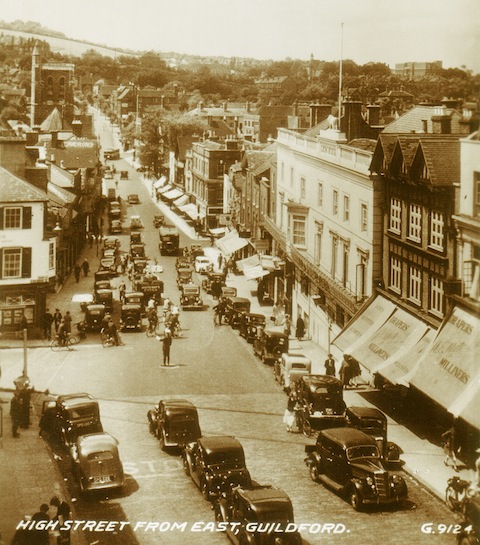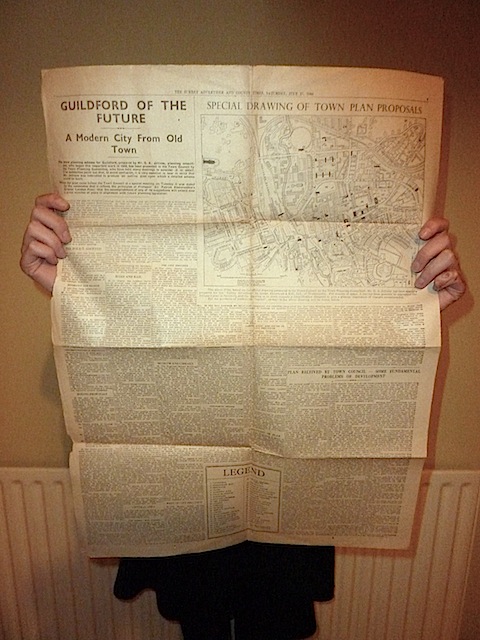 Abraham Lincoln
If given the truth, the people can be depended upon to meet any national crisis...
Abraham Lincoln
If given the truth, the people can be depended upon to meet any national crisis...
 Guildford news...
for Guildford people, brought to you by Guildford reporters - Guildford's own news service
Guildford news...
for Guildford people, brought to you by Guildford reporters - Guildford's own news service
Guildford Of The Future – How It Was Suggested Back In 1946
Published on: 6 Dec, 2013
Updated on: 6 Dec, 2013
By David Rose
This week has seen the completion of the Issues and Options consultation for Guildford borough’s new Local Plan. The Guildford Dragon NEWS has reported on it a good deal and there has been an equal amount of correspondence from readers.
From a history perspective, let’s look back 67 years to a planning scheme for Guildford that was published in July 1946, and which had been two years in the preparation.
It’s fascinating to go back in time and to see what was being proposed and to muse over what was actually built and created.
It was prepared by planning consultant Geoffrey Jellicoe. He was asked by the council to produce an outline plan upon which a detailed scheme could be produced.
Diversity and balance for the town were key words. The plan was to “encourage the community to be diversified and well-balanced in character”. The highest standards were to be provided for “home life, including education, daily amenities and philosophy”.
Guildford was to be encouraged to “develop some light industries, but to discourage heavy industry”. To “establish Guildford as a cultural centre for the arts and especially music; as a summer open-air resort and especially for cricket; as a shopping centre; as a market; as a legal centre; and as a city having a spiritual quality”.
Do you think those elements can be found in our borough today, a Guildford that is now termed as a regional centre? Guildford Cathedral was not completed at the time of Jellicoe’s report, but it was assumed by many that once it was, Guildford would become a city, of which, of course, it hasn’t.
But it’s the fine detail of suggestions that make interesting reading today. Here are a few of the ‘gems’ that can be found in the report. My notes of specific places and features in square brackets.
“The existing road through Stoke Park [A3] would become a 15mph Park Drive.”
“A perimeter road round the outskirts of the neighbourhood (excepting Burpham) connects with the A3 at Hog’s Back in a proposed considerable new subterranean junction.”
“The Godalming road is diverted through a tunnel under the Hog’s Back, and joins the Farnham Road clear of railway traffic obstructions.”
“Connections to A3 are reduced and eased as much as possible.”
“Three new railway stations are proposed where the perimeter road crosses the three lines. Each should include a substantial car park.”
“No airport is possible within the borough boundary. A helicopter park could be established on the Fair Ground [Woodbridge Meadows] and possibly on top of the station.”
“Foxenden Quarry becomes an open air theatre, with easy access from car park, and to one of the halls in case of inclement weather.”
“The Grammar School buildings become the Museum, with gardens.”
“Castle Street and Sydenham Road are widened to receive local traffic.”
“The area lying north of North Street is now compressed and characterless. The Plan eliminates certain roads and creates two quiet squares.”
“The Quarry Street by-pass should sink into the landscape and the west side might have a soil embankment to keep the passing vehicles remote from the adjoining river.”
“Total change is proposed between existing bridges [Town Bridge and Bridge Street Bridge]. The power station [now the Electric Theatre] remains ultimately to contain atomic power.”
“A site of character presents itself at the end of Denzil Road [off Guildford Park Road], the view of which would focus the attention from High Street, and thus suggesting a link between City and Cathedral precincts.”
“Between Woodbridge Road and Stoke Road there is a colony of modern flats, sufficient to accommodate the same numbers, but not the same character, of those now occupying the site.”
“A site north of the bridge on the London Road is suitable for a good class office building of some magnitude.”

Guildford High Street at about the time when plans were being drawn up to create ‘a modern city from an old town’.
Bernard Parke commented on the 1946 plan, including some of the suggestions in it as listed above, in the book we co-wrote, Guildford Remember When (Breedon Books 2007). He noted: “These were the bare bones of the proposal put to the full council in those dark and austere days of the mid-1940s. Since then, a proposed central bus station has been adopted. We have an urban motorway, although back then the world ‘motorway’ was not used as such, and instead these roads were described as a ‘road operating a rail system’.
“The plan received cautious approval, but a lack of funds hindered much being done at first. Besides, councillors did not wish to impose an increase on the rates.”
Responses to Guildford Of The Future – How It Was Suggested Back In 1946
Leave a Comment Cancel replyPlease see our comments policy. All comments are moderated and may take time to appear.
Recent Articles
- Guildford Institute’s Crowdfunding Project for Accessible Toilet in its New Community and Wellbeing Centre
- Letter: Guildford – Another Opportunity Missed?
- Letter: GBC’s Corporate Strategy – Where Is the Ambition?
- My Memories of John Mayall at a Ground-breaking Gig in Guildford Nearly Six Decades Ago
- Westborough HMO Plans ‘Losing the Heart of the Street’ Says Resident
- College Invests to Boost Surrey’s Economy and Close Digital Skills Gap
- Community Lottery Brings Big Wins for Local Charities
- GBC Housing Plan Promises ‘A Vibrant Urban Neighbourhood’ Near Town Centre
- Hospital Pillows ‘Shortage’ at the Royal Surrey
- Updated: Caravans Set Up Camp at Ash Manor School


Recent Comments
- Ian Macpherson on Updated: Main Guildford to Godalming Road Closed Until August 1
- Sara Tokunaga on GBC Housing Plan Promises ‘A Vibrant Urban Neighbourhood’ Near Town Centre
- Michael Courtnage on Daily Mail Online Reports Guildford Has Highest-paid Council Officer
- Alan Judge on GBC Housing Plan Promises ‘A Vibrant Urban Neighbourhood’ Near Town Centre
- John Perkins on GBC Housing Plan Promises ‘A Vibrant Urban Neighbourhood’ Near Town Centre
- S Collins on GBC Housing Plan Promises ‘A Vibrant Urban Neighbourhood’ Near Town Centre
Search in Site
Media Gallery
Dragon Interview: Local Artist Leaves Her Mark At One of England’s Most Historic Buildings
January 21, 2023 / No Comment / Read MoreDragon Interview: Lib Dem Planning Chair: ‘Current Policy Doesn’t Work for Local People’
January 19, 2023 / No Comment / Read MoreA3 Tunnel in Guildford ‘Necessary’ for New Homes, Says Guildford’s MP
January 10, 2023 / No Comment / Read More‘Madness’ for London Road Scheme to Go Ahead Against ‘Huge Opposition’, Says SCC Leader
January 6, 2023 / No Comment / Read MoreCouncillor’s Son Starts Campaign for More Consultation on North Street Plan
December 30, 2022 / No Comment / Read MoreCounty Council Climbs Down Over London Road Works – Further ‘Engagement’ Period Announced
December 14, 2022 / No Comment / Read MoreDragon Interview: GBC Reaction to the Government’s Expected Decision to Relax Housing Targets
December 7, 2022 / No Comment / Read MoreHow Can Our Town Centre Businesses Recover? Watch the Shop Front Debate
May 18, 2020 / No Comment / Read More










Andrew Backhurst
December 9, 2013 at 10:13 pm
I wonder what plans the town and Jellicoe had for Guildford City FC? At that time the team had finished first and second in the 1938 and 1939 seasons in the Southern League and had been attracting large crowds at their Joseph’s Road ground.
But during the war the ground had been taken over by the War Department and had fallen into disrepair.
The club had to spend huge amounts of money to fix the ground before football could continue, but when it did City again finished the 1946/47 season in second place and must have had ambitions to move up into the Football League in the coming seasons.
Any forward-thinking town must have viewed Guildford City as a Football League club – an asset for putting the town on the map and no doubt would have had plans to use them to their advantage.
I would love to know more about this.
[David Rose replies: The article on the Jellicoe report that appeared in the Surrey Advertiser in 1946 states that what was published was ‘the plan’, so I guess that’s it in full. I can find no mention of football in it. Which is strange, given what you accurately note as the successes of ‘The City’ back then – facts that are still well known to die-hand and long-standing fans to this day.
Perhaps Jellicoe was more of a cricket fan! He bangs on about enlarging the ‘existing delightful cricket ground’ (Woodbridge Road). He suggested that it be extended to the river and made into a ground fit for county cricket.
Of course, it was not extended, but county cricket is played there once a year by a London-based team who go by the name of Surrey.
I’m not much of a cricket fan, but I always get the impression that the pitch is a bit on the small side. Bit like the Monaco Grand Prix that’s been likened to riding a bike round a small bedroom!]